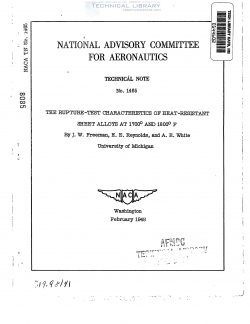naca-tn-1465
- Version
- 94 Downloads
- 2.93 MB File Size
- 1 File Count
- December 4, 2016 Create Date
- December 4, 2016 Last Updated
National Advisory Committee for Aeronautics, Technical Notes - The Rupture Test Characteristics of Heat Resistant Sheet Alloys at 1700° and 1800°F

The characteristics of a representative group of heat-resistant
alloys in sheet form were investigated by rupture tests at 1700° and
1800° F. The primary purpose was to provide data which could be used
by the aircraft industry to determine whether the rupture-test proper-
ties of an alloy would be a criterion of service performance in com-
bustion chambers and other applications of sheet alloys at high temper-
atures in power plants for aircraft. Suitable service data were not
available for this type of correlation in the present report.
The materials studied included the standard chromium-nickel
types 330 (35Ni-150r), 310 (250r-20Ni), 310$ (250r-20Ni+Si),
309 (250r-12Ni), and Inconel alloys, the new highly alloyed materials
known as VitaJlium, Co-Cr-Ni, 8816, S590, and low-carbon N-155, and
four experimental alloys containing cobalt, molybdenum, tungsten, and
boron in addition to nickel and chromium. The highly alloyed materials,
in most cases, had higher rupture strengths only for time periods up
to about 1000 hours at 17000 F and for somewhat shorter time periods at
1800° F. The relative rupture strengths varied with the time period and
the temperature considered. In general, Vitallium, J-838, and 8-590 were
the strongest of the new alloys and type 3108 was the best of the standard
alloys. Low-carbon 11-155 apparently had the best strength at time periods
of 1000 hours and longer.
The rupture strengths at 1700° F ranged up to 12,000, 8000, 5200, and
3900 psi for fracture in 10, 100, #00, and 1000 hours, respectively. The
corresponding range in rupture strengths at 1800° F was up to 8600, l#200,
2500, and 2000 psi.
Rather wide differences in properties of separate heats of type 3108
and Inconel alloys showed that treatment prior to testing influenced the
rupture-test characteristics. The apparent equalization of rupture
strengths at the longer time periods was attributed to agglomeration,
solution, or lack of precipitation of the excess constituents believed to
impart high napture strength to some of the alloys at lower temperatures.
Apparently the strengths of the various matrix materials were not greatly
different. Service conditions under which corrosion would differ from
that during the rupture tests would result in different rupture properties.
Presumably a less-oxidizing condition would improve the performance by
some of the alloys.
| File | Action |
|---|---|
| naca-tn-1465 The Rupture Test Characteristics of Heat Resistant Sheet Alloys at 1700° and 1800°F.pdf | Download |

Comment On This Post